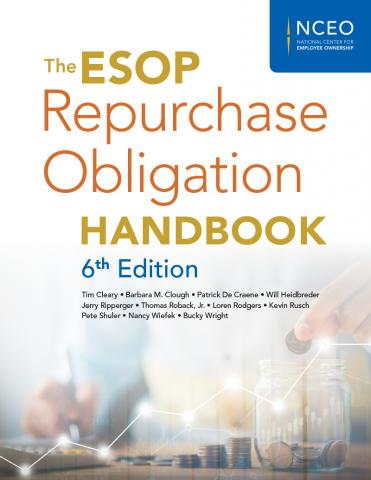Description
Every closely held company with an ESOP has a legal obligation to offer to buy back stock distributed to ESOP participants; this is called the "repurchase obligation." Written by leading experts, this book combines practical discussions with research in exploring the repurchase obligation and how it can be planned for and dealt with. A major feature of the sixth edition, which includes updates to almost every chapter, is a detailed report on the NCEO's 2023 survey of how ESOP companies handle their repurchase obligations, including dozens of tables. The survey respondents described their distribution practices, diversification policies, confidence about their ability to meet their obligations, and other issues regarding repurchase obligations. This includes written responses from the respondents with insight and advice from their experiences.
Product Details
Table of Contents
Preface
1. Introduction
2. The Repurchase Obligation: Paying Up
3. The ESOP Repurchase Obligation Study
4. The Repurchase Obligation in S Corporations
5. Funding ESOP Repurchase Obligations
6. Repurchase Obligation Impact on Sponsor Company Share Value
7. Should You Releverage Your ESOP?
8. Nuts and Bolts of an ESOP Releveraging Transaction
9. The 2023 NCEO Repurchase Obligation Survey
About the Authors
About the NCEO
Excerpts
From chapter 2, "The Repurchase Obligation: Paying Up" (footnote omitted)
Plans may contain an early retirement provision, usually accompanied by a years-of-service or plan participation requirement, such as age 55 and 10 years of service, or age 60 and 20 years of service. If there are age and service provisions, and a departed participant has completed the service requirement, the participant’s benefit must be made available to them when they reach the specified age. Any such provision may increase the rate at which a company has to pay its repurchase obligation and should be figured into a repurchase obligation forecast.
From chapter 3, "The ESOP Repurchase Obligation Study"
A second operational factor that affects relative balances in most ESOPs is the rate at which individual and group compensation changes. Clearly, if one group’s compensation is increasing faster than the other group’s compensation, we would expect its relative share of the ESOP to increase faster as well.
In fact, though, compensation increase rates tend to be the least sensitive variable in the process. First, changes in compensation tend to be generally uniform across the population, and therefore, there is no effect on the operational result. Second, at the level within the company at which we would most expect dramatic compensation increases, the law limits how much compensation we can take into account for plan purposes. This has the effect of dampening the benefit value of absolute compensation changes. Nevertheless, compensation change rates do serve to adjust the relative allocation of shares acquired based on contributions or forfeited upon termination among the groups. Hence, to the extent a particular subset of employees experiences compensation increases at a rate significantly faster than other subsets, its proportional ESOP holdings can be expected to increase faster as well. See table 3-4.
From chapter 4, "The Repurchase Obligation in S Corporations"
The special tax status of S corporation ESOPs affects not only the source of funding but also the funding mechanism used. In C corporations, recycling shares within the ESOP is generally less costly than redeeming shares from the ESOP. When recycling, the company makes a contribution to the ESOP equal to the value of the vested shares in the accounts of those receiving a distribution. The contribution is allocated to eligible participants who subsequently exchange this cash for the shares of the departing terminated participants. The cash received in the accounts of departing participants is then distributed to them. Alternatively, the ESOP can use cash contributed by the company to buy the shares distributed in kind to the participants.
From chapter 9, "The 2023 NCEO Repurchase Obligation Survey"
Plans that have been in effect for at least 10 years generally begin to face the statutory requirement to allow participants to diversify their accounts. Companies satisfy the statutory requirement in various ways, as shown in table 9-3.
Among the 172 companies with plans that are 10 or more years old, 9% report that no participants elected to diversify. On the other end of the spectrum, 16% report that a majority of eligible participants have chosen to diversify (table 9-4).
